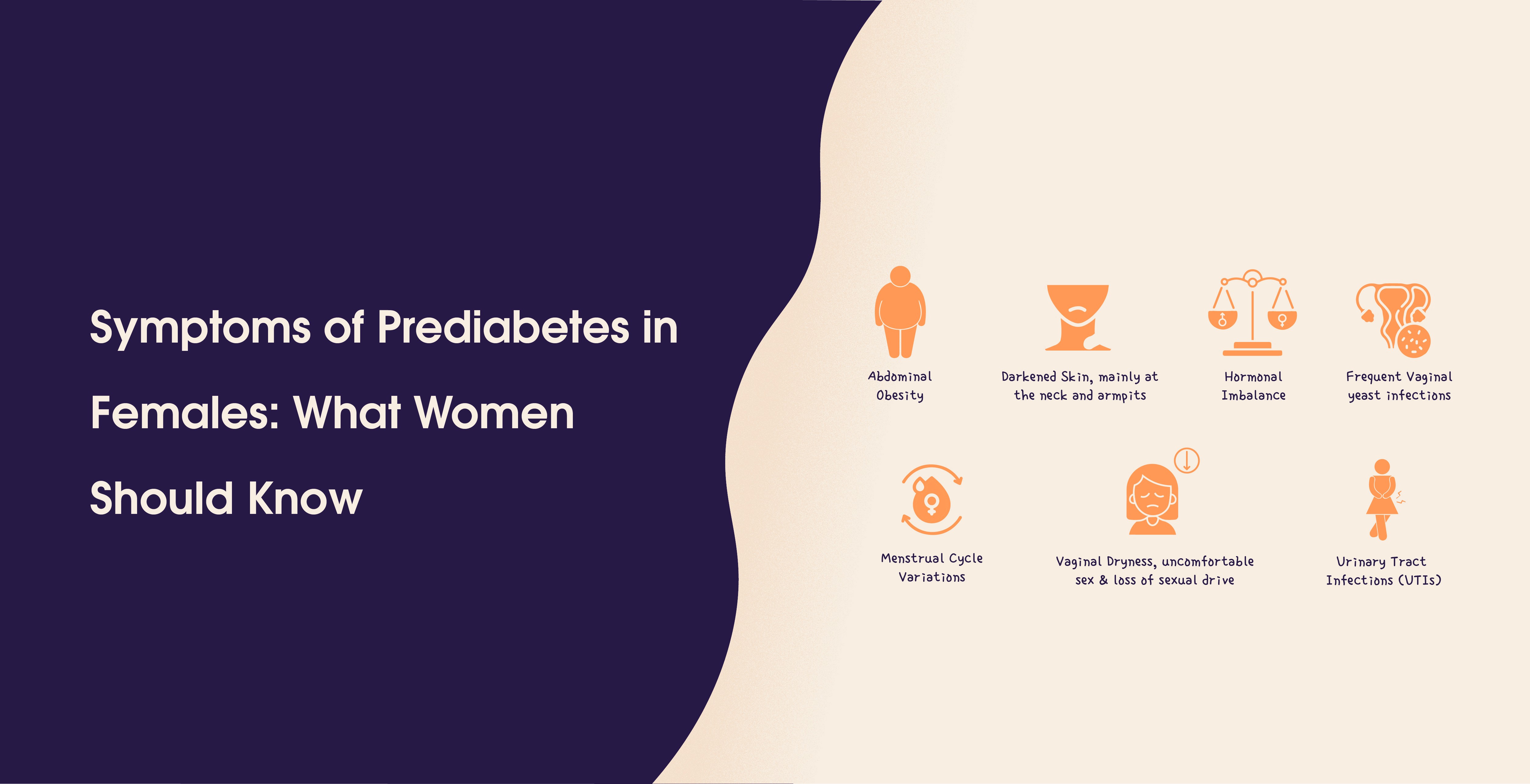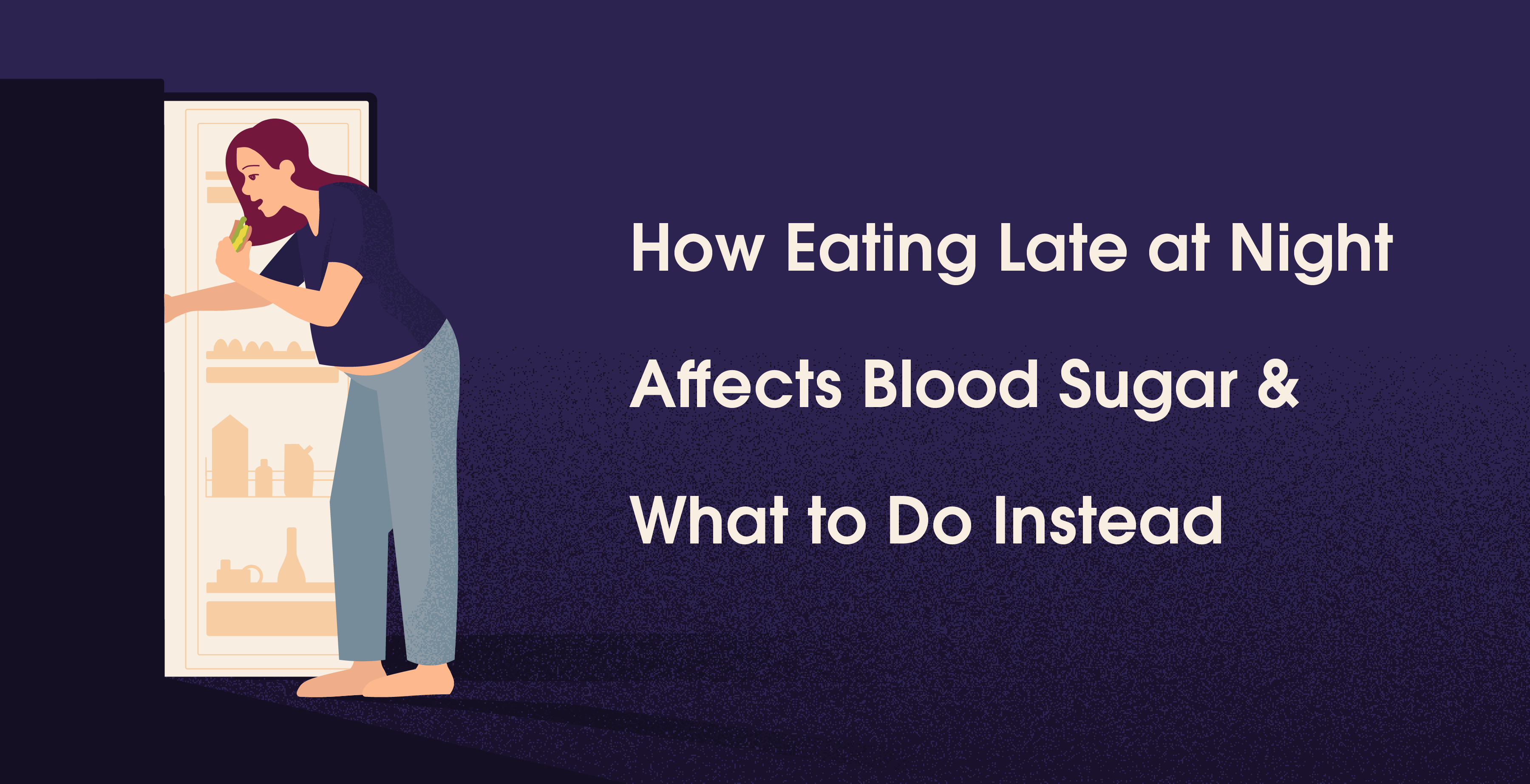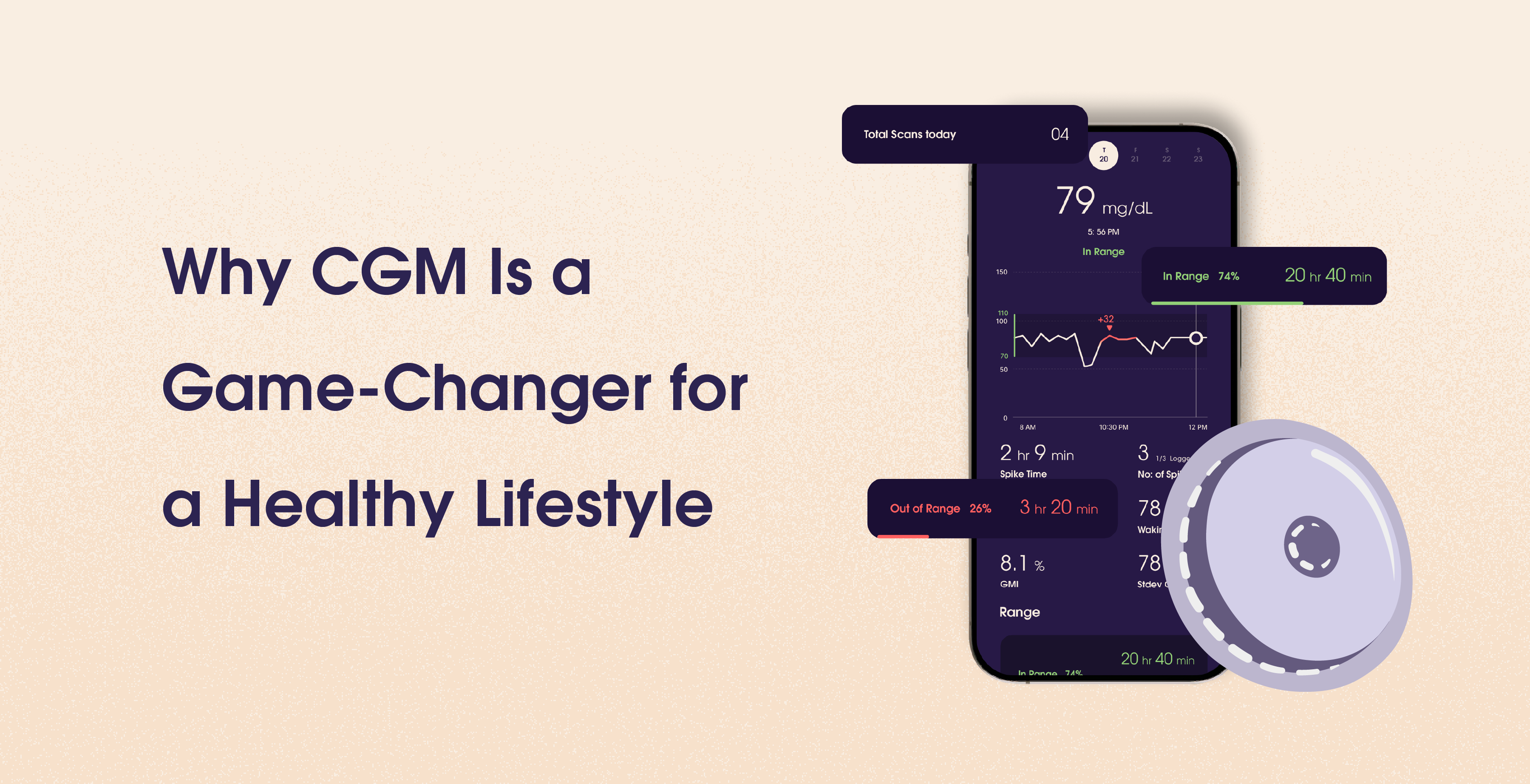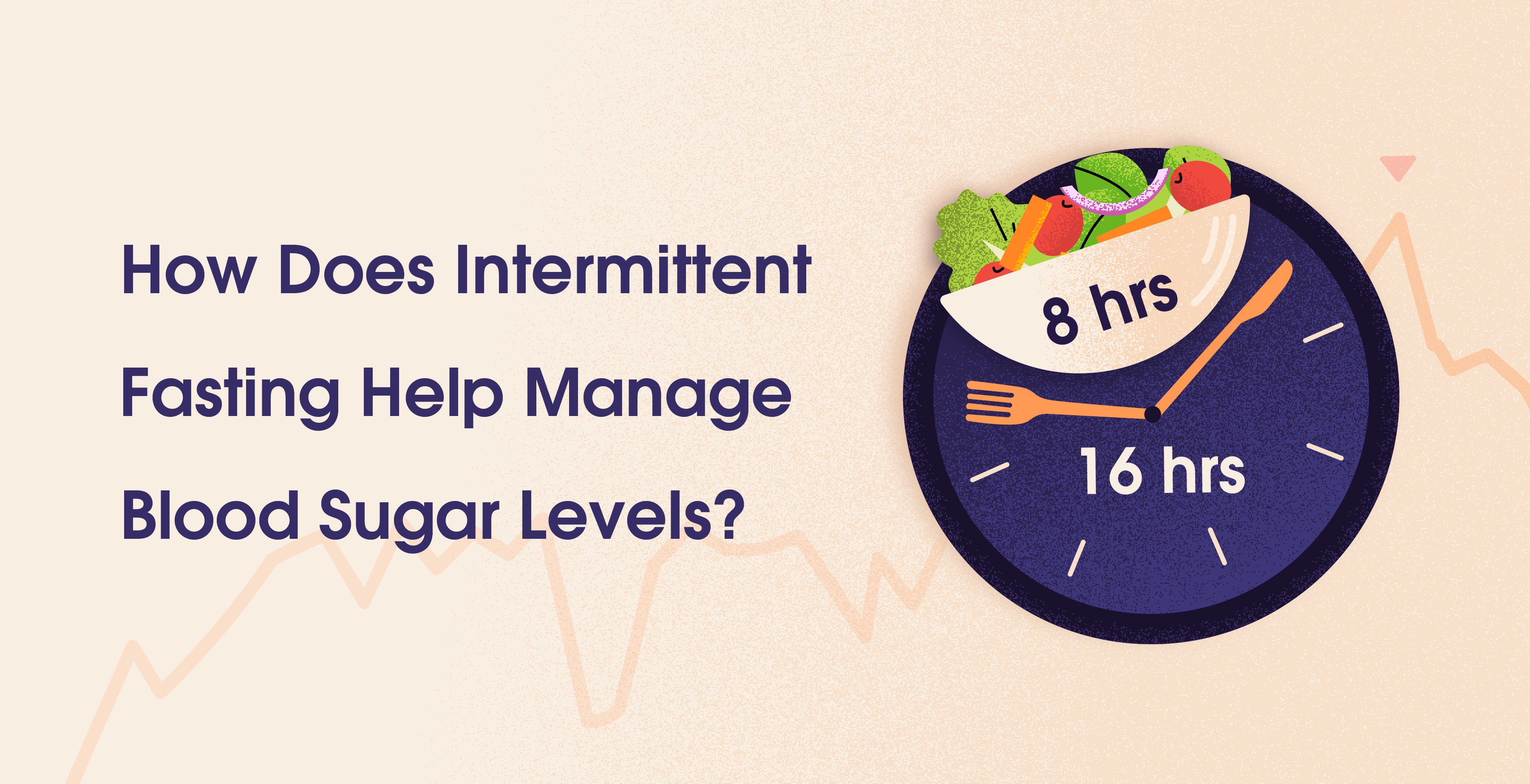Symptoms of Prediabetes in Females: What Women Should Know
Jan 14, 2024
Ashima Raizada



Table Of Contents
Experiencing insatiable cravings, sleep disruptions, added inflammation, skin concerns, and menstrual changes? Or perhaps you find yourself frequently fatigued with brain fog and irregular eating habits? If any of these sound familiar, it's time to focus on you!
Many women tend to delay their health needs, with 78% postponing doctor's appointments due to their busy lives. (1)
But what if these subtle changes are your body's way of warning you about prediabetes, a condition where blood sugar levels are elevated but not yet diabetic? It's a warning sign, letting you know you need to take care of things now before this snowballs into more severe issues like type 2 diabetes.
So, as women, we have our unique prediabetes journey. Now, let's explore what prediabetes looks like and what you can do to stay ahead of your blood sugar spikes.
Highlights
Prediabetes means your blood sugar levels are higher than normal but not yet diabetes.
It affects women differently and can show up with signs like unquenchable thirst, fatigue, blurry vision, frequent urination, infections, and darkened skin patches.
Certain factors, like age, family history, weight, steroids, or irregular periods, can raise your risk.
Good news: lifestyle changes like exercise, a balanced diet, and stress management can make a big difference in managing symptoms of prediabetes in females
Understanding Prediabetes in Females
A growing body of evidence now indicates that disruptions in the circadian rhythm may contribute to the development of type 2 diabetes. Long before this though, your body sends you a warning sign - something called prediabetes. What's also interesting to note is that studies show that the converse is true too. Research shows that people who are diabetic display strong signs of circadian rhythm disruptions, highlighting the codependency of these two. (1) But don't worry, this is actually great news! Let's understand this connection better to see why.When you deviate from your circadian rhythm, such as with shift work, international travel, or just staying out too late many nights a week, it throws off your body's glycaemic control. Experiments have shown that such disruptions can impair the function of insulin-producing cells in your pancreas, glucose regulation in your liver, nutrient absorption in your gut, and energy balance in your muscles. Taken together, these alterations ultimately can reduce our bodies' sensitivity to insulin. So after prolonged circadian disruption, whenever you consume food, especially carbs, sugars and starches, your body will find it much more difficult to absorb this excess glucose in your bloodstream. This then heightens the risk of glucose-related issues, ultimately increasing the likelihood of developing prediabetes and diabetes.
How are Symptoms of Prediabetes in Females Different?
For women, hormonal changes and menstrual cycles can lead to distinctive responses in blood sugar. According to the Centers for Disease Control and Prevention (CDC), men are more likely to receive a diabetes diagnosis than women. Other research also suggests that women with diabetes may have a higher chance of experiencing complications compared to men. These complications include depression, anxiety, stroke, heart disease and kidney disease. (2)
There are several variables that can sway blood sugar levels, making it crucial to be mindful of these factors. One intriguing theory for these gender differences in diabetes and its complications revolves around the role of sex hormones. Female hormones, like estrogen, often act as natural protectors against conditions such as heart and kidney diseases.
High blood sugar levels can interfere with the body's response to estrogen. This can weaken the protective effects of female hormones. So, when it comes to diabetes complications in women, it's a bit like a double whammy - the impact of high blood sugar and a reduced response to estrogen. Conditions such as polycystic ovary syndrome (PCOS) can also contribute to insulin resistance, a telltale sign of prediabetes. (3)
Common Symptoms of Prediabetes in Females
Prediabetes often progresses silently, showing no obvious symptoms. However, some common signs and symptoms may emerge in individuals, both men and women, which should serve as crucial warning signs. These symptoms include excessive thirst, unrelenting fatigue, frequent urination, and the development of skin tags. Blurred vision, a result of glucose-induced shifts in bodily fluids, can also be indicative of prediabetes.
However, more telling symptoms of prediabetes in females include:
Weight gain, especially around the abdomen:
If you find those extra pounds settling around your tummy, even though you're keeping active, it's a smart idea to check your blood sugar levels. The hormonal shifts that women experience can play a role in this kind of belly weight gain. It's important to note that this type of fat deposition is not merely about looks, but also a health risk, as it's associated with insulin resistance.
Darkened skin areas, particularly the neck and armpits
Darkened skin areas, known as acanthosis nigricans, can be another distinct symptom of prediabetes in females. This condition often shows up as dark, thickened skin patches in places like the neck, underarms, and groin. Insulin resistance, a precursor to prediabetes, can trigger an unusual increase in skin cell growth, causing these darker patches. While not limited to women, it's more frequently observed in females. (4)
Hormonal conditions like PCOS
If you have PCOS or any hormone imbalances, you are likely to build insulin resistance and have increased blood sugar. In fact, women with PCOS (polycystic ovary syndrome) are at higher risk of insulin resistance.
Those hormonal imbalances in PCOS can mess with your menstrual cycles, making them irregular. When your menstrual cycle isn't on a predictable schedule, it can be trickier to manage and foresee changes in your blood sugar levels. This unpredictability in your body's internal rhythms can make the blood sugar balancing act a bit more challenging.
Frequent vaginal yeast infections
While fungal infections can impact many women, those with diabetes or prediabetes are at a higher risk, especially when their blood sugar levels rise. This increase in sugar can lead to an overgrowth of yeast, particularly in the vaginal area, potentially resulting in a yeast infection. (5)
Urinary Tract Infections (UTIs)
Because of certain anatomical factors, women tend to have UTIs more often than men. When blood sugar levels are higher than they should be, the risk of UTIs increases. Alongside elevated blood glucose, inadequate blood flow and slower bladder emptying can further raise the chances of getting a urinary tract infection. (6)
Menstrual cycle variations
Hormonal changes that happen before and during our periods can throw a curveball in predicting our blood sugar levels. It's no surprise that many women often experience sugar cravings right before or during their periods, which can add an extra layer of challenge to managing symptoms of prediabetes in females (7)
Vaginal dryness, uncomfortable sex and loss of sexual drive
When your blood sugar is high, it can cause damage to your blood vessels, making it tough for your body to stay well-lubricated. This leads to vaginal dryness and can make sex uncomfortable and painful. Several factors like nerve issues, decreased blood flow, and hormonal shifts due to high blood sugar can contribute to this. (8) (9) (10)
Understanding these gender-specific symptoms, particularly for women, and their connection to prediabetes is crucial for early intervention and better management of the condition.
Complications Associated with Prediabetes in Women
Since the symptoms are mild and can be easily ignored, it's natural to not take them seriously. But while prediabetes may appear innocuous, it carries both short-term and long-term risks for women. In the short term, untreated prediabetes can lead to frequent infections, including vaginal yeast infections and urinary tract infections. These recurrent infections can disrupt daily life and cause discomfort.
In the long term, prediabetes can lead to more severe health complications. Women are at risk of developing gender-specific issues like gestational diabetes during pregnancy, which can affect both the mother and the baby. Furthermore, untreated prediabetes can lead to the dreaded type 2 diabetes, putting women at a higher risk of heart disease, kidney problems, nerve damage, vision impairment, and even pregnancy complications in the future.
Recognizing the importance of addressing prediabetes in women is not only vital for current health but also for preventing future complications that could impact their well-being and quality of life.
Taking Action: What Can Women Do About Prediabetes?
Lifestyle Changes
Once prediabetes is diagnosed, to improve the symptoms of prediabetes in females, you need to make some lifestyle and habit changes to overcome it. Here are some things you can do:
a) Get Moving:
Engage in exercises that put your muscles to work. Activities like strength training, dancing, or hiking help lower blood sugar levels by utilizing glucose as fuel. (11)
b) Mind Your Diet:
Avoid highly processed and deep-fried foods, which aren't suitable for anyone. Instead, focus on a balanced diet rich in fiber and protein. A protein-heavy and savory breakfast is a great start. Try a meal sequence of fiber, followed by proteins and fats, and then carbs and sugars. (12)
c) Prioritize Sleep:
Aim for 7-9 hours of quality sleep each night - aim for the amount you need to not feel tired at all during the following day. Your sleep patterns influence hormones, including insulin. Maintain a 3-4 hour gap between dinner and bedtime, get morning sunlight, and practice good sleep hygiene to reset your circadian rhythm.
d) Experiment with Intermittent Fasting:
Give intermittent fasting a shot by limiting your eating window to 8-10 hours. Ensure you have a balanced breakfast to allow your insulin to handle the incoming food. Keep dinner light, as your body is transitioning to its rest-and-digest state, resulting in slower digestion.
e) Stress Management:
High cortisol levels, your stress hormone, can contribute to various lifestyle disorders. Even when stress is not apparent, your body feels it through inflammation, sleep disturbances, and excessive exercise. Managing stress, whether it's work-related or otherwise, is crucial. Elevated cortisol often leads to increased blood sugar levels, which can result in conditions like depression, type 2 diabetes, and cardiovascular diseases. (13)
Consider joining a prediabetes management program
If you're in search of a comprehensive strategy to control your blood sugar levels, exploring a prediabetes management program is a valuable option. Studies show that making behavioral changes helped people with prediabetes lose 5-7% body weight and reduced their risk of developing type 2 diabetes by 58%. (14)
These programs provide structure and peer support, making lifestyle changes more accessible and motivating by sharing experiences. They also offer tools for effective progress tracking, ensuring accountability in monitoring dietary choices, physical activity, and blood sugar levels. But the most important part about these programs is that they give you access to a bunch of prediabetes education that you will require to understand your disease and body, without having to focus only on weightloss as the solution.
Consulting with a healthcare professional
a) Regular blood tests and screenings:
Seeking guidance from a healthcare professional is vital. Consistent blood tests and screenings are essential for evaluating your blood sugar levels and gaining valuable insights into managing prediabetes effectively.
b) Personalized advice and medication if required:
These experts provide you with advice that's just for you. Sometimes, they might suggest medicine along with lifestyle tweaks to help you keep your blood sugar in check.
Conclusion
Symptoms of prediabetes in females can vary and poses unique challenges due to its often subtle nature and the impact of hormonal fluctuations on blood sugar levels. Recognizing signs like unquenchable thirst, fatigue, skin changes, and menstrual irregularities is vital. Addressing these symptoms requires a proactive approach, including lifestyle modifications, participation in prediabetes management programs, and consultation with healthcare professionals. By taking early and consistent steps to manage symptoms of prediabetes in females, we can safeguard their well-being, prevent complications, and enjoy a healthier future.
References
Can Diabetes Cause Vaginal Yeast Infections?
If you're diabetic, your risk of getting a UTI is high! Here's how to avoid it.
Diabetes and Your Period: 5 Things Women Need to Know
Sexual Dysfunction in Women with Type 2 Diabetes Mellitus - PMC
Diabetes and sexual problems - in women.
How does diabetes affect sex life for men and for women?
Effects of aerobic exercises in prediabetes patients: a systematic review and meta-analysis - PMC.
The Glucose Goddess' hacks to curb your sugar cravings
Cortisol dysregulation: the bidirectional link between stress, depression, and type 2 diabetes mellitus - PMC
National Diabetes Prevention Program | CDC
Experiencing insatiable cravings, sleep disruptions, added inflammation, skin concerns, and menstrual changes? Or perhaps you find yourself frequently fatigued with brain fog and irregular eating habits? If any of these sound familiar, it's time to focus on you!
Many women tend to delay their health needs, with 78% postponing doctor's appointments due to their busy lives. (1)
But what if these subtle changes are your body's way of warning you about prediabetes, a condition where blood sugar levels are elevated but not yet diabetic? It's a warning sign, letting you know you need to take care of things now before this snowballs into more severe issues like type 2 diabetes.
So, as women, we have our unique prediabetes journey. Now, let's explore what prediabetes looks like and what you can do to stay ahead of your blood sugar spikes.
Highlights
Prediabetes means your blood sugar levels are higher than normal but not yet diabetes.
It affects women differently and can show up with signs like unquenchable thirst, fatigue, blurry vision, frequent urination, infections, and darkened skin patches.
Certain factors, like age, family history, weight, steroids, or irregular periods, can raise your risk.
Good news: lifestyle changes like exercise, a balanced diet, and stress management can make a big difference in managing symptoms of prediabetes in females
Understanding Prediabetes in Females
A growing body of evidence now indicates that disruptions in the circadian rhythm may contribute to the development of type 2 diabetes. Long before this though, your body sends you a warning sign - something called prediabetes. What's also interesting to note is that studies show that the converse is true too. Research shows that people who are diabetic display strong signs of circadian rhythm disruptions, highlighting the codependency of these two. (1) But don't worry, this is actually great news! Let's understand this connection better to see why.When you deviate from your circadian rhythm, such as with shift work, international travel, or just staying out too late many nights a week, it throws off your body's glycaemic control. Experiments have shown that such disruptions can impair the function of insulin-producing cells in your pancreas, glucose regulation in your liver, nutrient absorption in your gut, and energy balance in your muscles. Taken together, these alterations ultimately can reduce our bodies' sensitivity to insulin. So after prolonged circadian disruption, whenever you consume food, especially carbs, sugars and starches, your body will find it much more difficult to absorb this excess glucose in your bloodstream. This then heightens the risk of glucose-related issues, ultimately increasing the likelihood of developing prediabetes and diabetes.
How are Symptoms of Prediabetes in Females Different?
For women, hormonal changes and menstrual cycles can lead to distinctive responses in blood sugar. According to the Centers for Disease Control and Prevention (CDC), men are more likely to receive a diabetes diagnosis than women. Other research also suggests that women with diabetes may have a higher chance of experiencing complications compared to men. These complications include depression, anxiety, stroke, heart disease and kidney disease. (2)
There are several variables that can sway blood sugar levels, making it crucial to be mindful of these factors. One intriguing theory for these gender differences in diabetes and its complications revolves around the role of sex hormones. Female hormones, like estrogen, often act as natural protectors against conditions such as heart and kidney diseases.
High blood sugar levels can interfere with the body's response to estrogen. This can weaken the protective effects of female hormones. So, when it comes to diabetes complications in women, it's a bit like a double whammy - the impact of high blood sugar and a reduced response to estrogen. Conditions such as polycystic ovary syndrome (PCOS) can also contribute to insulin resistance, a telltale sign of prediabetes. (3)
Common Symptoms of Prediabetes in Females
Prediabetes often progresses silently, showing no obvious symptoms. However, some common signs and symptoms may emerge in individuals, both men and women, which should serve as crucial warning signs. These symptoms include excessive thirst, unrelenting fatigue, frequent urination, and the development of skin tags. Blurred vision, a result of glucose-induced shifts in bodily fluids, can also be indicative of prediabetes.
However, more telling symptoms of prediabetes in females include:
Weight gain, especially around the abdomen:
If you find those extra pounds settling around your tummy, even though you're keeping active, it's a smart idea to check your blood sugar levels. The hormonal shifts that women experience can play a role in this kind of belly weight gain. It's important to note that this type of fat deposition is not merely about looks, but also a health risk, as it's associated with insulin resistance.
Darkened skin areas, particularly the neck and armpits
Darkened skin areas, known as acanthosis nigricans, can be another distinct symptom of prediabetes in females. This condition often shows up as dark, thickened skin patches in places like the neck, underarms, and groin. Insulin resistance, a precursor to prediabetes, can trigger an unusual increase in skin cell growth, causing these darker patches. While not limited to women, it's more frequently observed in females. (4)
Hormonal conditions like PCOS
If you have PCOS or any hormone imbalances, you are likely to build insulin resistance and have increased blood sugar. In fact, women with PCOS (polycystic ovary syndrome) are at higher risk of insulin resistance.
Those hormonal imbalances in PCOS can mess with your menstrual cycles, making them irregular. When your menstrual cycle isn't on a predictable schedule, it can be trickier to manage and foresee changes in your blood sugar levels. This unpredictability in your body's internal rhythms can make the blood sugar balancing act a bit more challenging.
Frequent vaginal yeast infections
While fungal infections can impact many women, those with diabetes or prediabetes are at a higher risk, especially when their blood sugar levels rise. This increase in sugar can lead to an overgrowth of yeast, particularly in the vaginal area, potentially resulting in a yeast infection. (5)
Urinary Tract Infections (UTIs)
Because of certain anatomical factors, women tend to have UTIs more often than men. When blood sugar levels are higher than they should be, the risk of UTIs increases. Alongside elevated blood glucose, inadequate blood flow and slower bladder emptying can further raise the chances of getting a urinary tract infection. (6)
Menstrual cycle variations
Hormonal changes that happen before and during our periods can throw a curveball in predicting our blood sugar levels. It's no surprise that many women often experience sugar cravings right before or during their periods, which can add an extra layer of challenge to managing symptoms of prediabetes in females (7)
Vaginal dryness, uncomfortable sex and loss of sexual drive
When your blood sugar is high, it can cause damage to your blood vessels, making it tough for your body to stay well-lubricated. This leads to vaginal dryness and can make sex uncomfortable and painful. Several factors like nerve issues, decreased blood flow, and hormonal shifts due to high blood sugar can contribute to this. (8) (9) (10)
Understanding these gender-specific symptoms, particularly for women, and their connection to prediabetes is crucial for early intervention and better management of the condition.
Complications Associated with Prediabetes in Women
Since the symptoms are mild and can be easily ignored, it's natural to not take them seriously. But while prediabetes may appear innocuous, it carries both short-term and long-term risks for women. In the short term, untreated prediabetes can lead to frequent infections, including vaginal yeast infections and urinary tract infections. These recurrent infections can disrupt daily life and cause discomfort.
In the long term, prediabetes can lead to more severe health complications. Women are at risk of developing gender-specific issues like gestational diabetes during pregnancy, which can affect both the mother and the baby. Furthermore, untreated prediabetes can lead to the dreaded type 2 diabetes, putting women at a higher risk of heart disease, kidney problems, nerve damage, vision impairment, and even pregnancy complications in the future.
Recognizing the importance of addressing prediabetes in women is not only vital for current health but also for preventing future complications that could impact their well-being and quality of life.
Taking Action: What Can Women Do About Prediabetes?
Lifestyle Changes
Once prediabetes is diagnosed, to improve the symptoms of prediabetes in females, you need to make some lifestyle and habit changes to overcome it. Here are some things you can do:
a) Get Moving:
Engage in exercises that put your muscles to work. Activities like strength training, dancing, or hiking help lower blood sugar levels by utilizing glucose as fuel. (11)
b) Mind Your Diet:
Avoid highly processed and deep-fried foods, which aren't suitable for anyone. Instead, focus on a balanced diet rich in fiber and protein. A protein-heavy and savory breakfast is a great start. Try a meal sequence of fiber, followed by proteins and fats, and then carbs and sugars. (12)
c) Prioritize Sleep:
Aim for 7-9 hours of quality sleep each night - aim for the amount you need to not feel tired at all during the following day. Your sleep patterns influence hormones, including insulin. Maintain a 3-4 hour gap between dinner and bedtime, get morning sunlight, and practice good sleep hygiene to reset your circadian rhythm.
d) Experiment with Intermittent Fasting:
Give intermittent fasting a shot by limiting your eating window to 8-10 hours. Ensure you have a balanced breakfast to allow your insulin to handle the incoming food. Keep dinner light, as your body is transitioning to its rest-and-digest state, resulting in slower digestion.
e) Stress Management:
High cortisol levels, your stress hormone, can contribute to various lifestyle disorders. Even when stress is not apparent, your body feels it through inflammation, sleep disturbances, and excessive exercise. Managing stress, whether it's work-related or otherwise, is crucial. Elevated cortisol often leads to increased blood sugar levels, which can result in conditions like depression, type 2 diabetes, and cardiovascular diseases. (13)
Consider joining a prediabetes management program
If you're in search of a comprehensive strategy to control your blood sugar levels, exploring a prediabetes management program is a valuable option. Studies show that making behavioral changes helped people with prediabetes lose 5-7% body weight and reduced their risk of developing type 2 diabetes by 58%. (14)
These programs provide structure and peer support, making lifestyle changes more accessible and motivating by sharing experiences. They also offer tools for effective progress tracking, ensuring accountability in monitoring dietary choices, physical activity, and blood sugar levels. But the most important part about these programs is that they give you access to a bunch of prediabetes education that you will require to understand your disease and body, without having to focus only on weightloss as the solution.
Consulting with a healthcare professional
a) Regular blood tests and screenings:
Seeking guidance from a healthcare professional is vital. Consistent blood tests and screenings are essential for evaluating your blood sugar levels and gaining valuable insights into managing prediabetes effectively.
b) Personalized advice and medication if required:
These experts provide you with advice that's just for you. Sometimes, they might suggest medicine along with lifestyle tweaks to help you keep your blood sugar in check.
Conclusion
Symptoms of prediabetes in females can vary and poses unique challenges due to its often subtle nature and the impact of hormonal fluctuations on blood sugar levels. Recognizing signs like unquenchable thirst, fatigue, skin changes, and menstrual irregularities is vital. Addressing these symptoms requires a proactive approach, including lifestyle modifications, participation in prediabetes management programs, and consultation with healthcare professionals. By taking early and consistent steps to manage symptoms of prediabetes in females, we can safeguard their well-being, prevent complications, and enjoy a healthier future.
References
Can Diabetes Cause Vaginal Yeast Infections?
If you're diabetic, your risk of getting a UTI is high! Here's how to avoid it.
Diabetes and Your Period: 5 Things Women Need to Know
Sexual Dysfunction in Women with Type 2 Diabetes Mellitus - PMC
Diabetes and sexual problems - in women.
How does diabetes affect sex life for men and for women?
Effects of aerobic exercises in prediabetes patients: a systematic review and meta-analysis - PMC.
The Glucose Goddess' hacks to curb your sugar cravings
Cortisol dysregulation: the bidirectional link between stress, depression, and type 2 diabetes mellitus - PMC
National Diabetes Prevention Program | CDC
Table Of Contents
Table Of Contents
Table Of Contents
Read More


Mar 25, 2025
Sayfali Rawlani


Mar 20, 2025
Sayfali Rawlani


Mar 6, 2025
Sayfali Rawlani



Company
Copyright © 2025 trst health. All right reserved.

